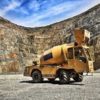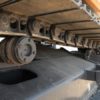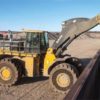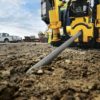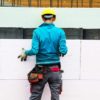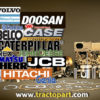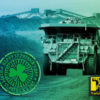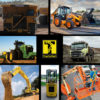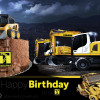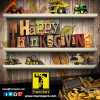Compact Track Loader Helps Penn-dale Farms Lift More, Work Faster
|
Penn-dale Farms first broke ground in Hastings, Michigan in 1972. Owned and operated by the Pennington family – Jack and Gloria, and their son Dennis – the farm has been tended to by four generations (Dennis’ son is also in the business) and now resides on land that has been in Gloria’s family since 1948.
The farm raises beef cattle, but the bulk of their work comes from a custom baling business. Penn-dale Farms bales and stores large square bales of wheat straw and hay for other farmers in the region. On average, they put up around 5,000 large bales a year.
Speed is critical for the business, as timing baling and hauling with the weather, harvest schedules on multiple plots and work on their own farm can be tough to do. Working faster and more efficiently helps them keep ahead. It’s with that eye to speed and efficiency that the farm added a CASE TR310 compact track loader to its fleet.
“We used to have three skid loaders in the field putting bales together in piles,” says Dennis Pennington. “With this one machine with a higher speed, I could keep up with just that one track machine instead of having three of them in the field.”
“It’s one of the most important pieces of equipment that we have and the one that we use the most,” says Dennis.
Transitioning from Skid Steers to CTLs
Penn-dale Farms bought its first CASE skid steer, an 1840, in 1990. Ten years later, they added an 1845C.
“The 1840 became one of the most handy machines that you could have on a farm,” says Dennis.
Jack Pennington agrees: “The 1840 and 1845C have been excellent. We don’t have any problems with them whatsoever. They’re just dependable.”
The new TR310 compact track loader is used for loading and moving bales, brush hogging pasture and assisting with day-to-day chores around the farm.
“We chose this size because it was small enough that we can transport with the trucks and trailers that we have, yet big enough to pick up and move the bales [we work with],” says Dennis.
One of the primary reasons Penn-dale chose the TR310 was the standard hand controls, similar to what they were comfortable with in their current fleet.
“We ended up with the CASE TR310 because it has the hand controls that we’re used to from the 1840 and 1845C,” says Dennis. “We tried foot controls. We didn’t like them. We’re used to the hand controls the way they used to be, and that was the only machine that offered that feature.”
Another important feature for Penn-dale was ground speed (up to 7.6 miles per hour in high range). The speed of the TR310 actually allowed them to take a couple of guys out of the field and put them to work doing other tasks on the farm.
“That higher ground speed is one of the things that we really noticed with this particular machine,” Dennis says. “With the speed of the machine, we were able to cut out two people working, as well as two machines in the field, and we were able to keep up.”
Traversing across fields can also mean a bumpy ride. Dennis found that the TR310 offers a smooth ride while still moving at a higher speed thanks to its Ride Control feature. Ride control effectively dampens the movement of the loader arms to provide a smoother ride and allow for greater material retention/stability.
“When you’re running that thing in the highest speed across the wide-open field, it is much smoother,” Dennis says. “You wouldn’t believe how much smoother the track machine is going across the field.”
Reaching For the Top
Lifting capacity was an important factor for Penn-dale Farms. Tracked machines generally have greater lifting capacities when compared to skid steers, as the tracks provide greater stability and more surface contact with the ground. The rated operating capacity of the TR310 (3,100 pounds) allows them to easily load two bales at a time, and unload three bales at a time.
“With this machine, we can lift about 2,400 pounds, picking bales off from the trailer without having the rear end come up off the ground,” Dennis says. “It’s both stable and safe.”
“With the track loader, I can just back right around and set them on a trailer with no problem. We haven’t been able to do that before. It saves half the time,” Jack adds.
“On our trailers, we stack bales three high,” Dennis says. “With the TR310, we can actually pick all three bales off and set them on the ground. It used to be we’d have to pick two bales off, set them down, and then come back and get the bottom bale. Now, we can actually move bales faster and unload them faster off the trailers.”
Expanding Access with Lower Ground Pressure
Most farms include lowlands that can be soggy and hard to traverse. Wheeled machines cause ruts in those areas and bottom out, leaving a mess and creating opportunities for machines to get stuck. Compact track loaders provide greater flotation and lower ground pressure, which allows them to be more effective in these conditions.
The TR310 offers tracks that measure 15.75 inches across and a wider stance that provides stability, better tractive effort and a low ground pressure of only 5.0 psi – allowing it to handle even the soggiest of ground conditions.
“Having that wide track and low ground pressure – where, normally, if you just drive a tractor over there, you’re going to cut it and dig in – it floats right across the top,” says Dennis. “That has been very useful and very beneficial. It makes more of the farm accessible, where with a tired machine, not so much. It brings your center of gravity closer to the ground which makes the machine just more stable as you’re moving bales around.”
“I’ve got certain areas that, over the years, has grown in with trees,” says Jack. “Since we’ve been here [with this machine] we’ve been pasturing and clearing out some of them trees and we’re gaining ground that we couldn’t use before.”
Keeping it Clean
With most of its time spent in fields, around straw and on dirt, the machine can acquire a good amount of debris. The machine has been designed to keep more debris out, and is easier to clean out with a forward-tilting cab and large cutouts in the undercarriage that prevents material from accumulating.
“When you’re running it through the mud and through the dirt and through the fields, you get a bunch of material gathered underneath there,” says Dennis. “Trying to clean that out can be a real challenge and a pain in the neck. Hopefully, this new design will make it easier for us to clean out underneath there.”
